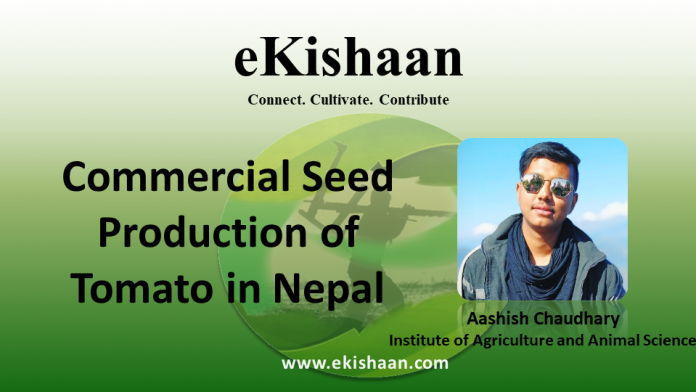COMMERCIAL SEED PRODUCTION OF TOMATO IN NEPAL
Tomato is one of the most important vegetable crops grown extensively in the tropical and subtropical belts of the world. It is edible red berry of tomato plant. Increased attention is now being bestowed to breeding and production of tomato. Tomato being self-pollinated crop makes it slight easy for its seed production. As seed production is a specialized job so their culture requires more detailed attention and handling. Production of tomato can further be increased if improved cultural practices are combined with good quality seeds.
The fruits are harvested after full maturity of the fruit when turn in to red color fruits from first and last one or two harvests should not be used for seed extraction. Seed matures as: Mature green, Breaker, Turning, Pink, Red, Dark red / over ripe. The fruits from in between 6-7 harvest should be used for seed extraction. The seed viability is depending on the method on which the seeds were extracted and hence, it is more important to choose proper methods of seed extraction. Before seed extraction, the fruits are to be graded for true to type and selection of medium to large size fruits for getting higher recovery of quality seeds.
The acid method of seed extraction is the best method for tomato seed extraction. In this method, the fruits are to be crushed into pulp and taken in a plastic containers (or) cement tank. And then add 30 ml of commercial Hydrochloric acid per kg of pulp, stir well and allow it for ½ hour. In between this duration the pulp may be stirred well for one or two times. This facilitates the separation of seed and pulp. After ½ hour, the seeds will settle down at the bottom and then the floating fraction is to be removed. The collected seeds should be washed with water for three or four times. While following acid method we must use only plastic or stainless-steel containers or cement tank. Care must be taken to avoid the usage of iron or zinc containers, which will affect the viability potential of the seeds and as well damage to the containers due to chemical reaction with acid. For large scale seed extraction, we can use the tomato seed extractor developed by Tamil Nadu Agricultural University. The seeds extracted by this machine may again be treated with commercial Hydrochloric acid @ 2-3 ml/kg seed with equal volume of water for 3-5 minutes with constant stirring. And then seed should be washed with water for to four times. It is easy to dry the seeds extracted by acid method and also remove the fungus growth over the seed coat, thus seeds possess golden yellow color and high vigour.
In fermentation method, the fruits selected for seed are completely lost. The selected ripe fruits are harvested and kept for a day in wooden containers. They are crushed by hand; no fruit juice should be allowed to drain out. Entire mass is kept for 24 to 72 hours depending upon high and low temperature. Then fruit juice flesh will float at the top and seed will settle down at the bottom. The fermented mass is removed and the seeds are cleaned 8-10 times with clean water and later on, they are dried. Long fermentation may damage the seed.
In the alkali method, selected fruits are cut into halves and slimy mass containing seed scooped out in a vessel with wooden stick, the mass is treated with 300 gm of washing soda in 4 liter of boiling water in equal volume. When the mixture is cooled down, it is allowed to stand overnight. Next day, all the seed settle down at the bottom. Seeds are washed thoroughly.
After completion of any of the above method of processing seeds, the seeds are to be dried in the shade. It should never be dried in hot sun. the safe moisture content of the seed for grading is 8 to 9 per cent. Seeds can be graded using 6/64’’ round perforated sieve.
The seeds dried to safe moisture content after treating either with captan or thiram @ 2 g/kg can be stored for 15 months in moisture vapor pervious containers, while it can be stored in moisture vapor proof containers for 30 months.The widely accepted and utilized method of seed production is acid method and in Nepal it is commercial process of production of tomatoes seeds. Among the 3 methods, being the quickest way it if beneficial for the commercial production. Even-though the fermentation method of seed processing is low cost method which doesn’t require a lot more skilled person. It takes more time and seed recovery rate is also very low 0.5-0.6% (0.7-0.8% in alkali method and 0.8-1.0% in acid method). From this process dull seed color is obtained and might result in seed borne pathogens whereas the acid method bright color an d pathogen removed seeds are obtained. The luster of seeds is lost with alkali method. So ultimately for best market value and proper result the acid method is the best method of seed production in case of Nepal.
The promising varieties of tomatoes in Nepal are: PED, Pusa Ruby, Pusa-120, KS-2, Pant T-3, Arka Vikash, Arka Saurabh, CO-3, Pant Bahar, Pusa Sheetal- low temperature regime, Pusa Hybrid 1- high temperature regime, Pusa Sadabahar- High and low temperature regime, Pusa Gaurav, , Roma, Punjab Chhuhara, Pusa Uphar, Arka Saurabh. and hybrid varieties are: Pusa Hybrid-1, Pusa Hybrid-2, Pusa Hybrid-4, Rajni, Rashmi, ARTH-3, ARTH-4, MTH-6, Arka Vardav, NA-501, NA-601, Avinash-2.
Hence with proper variety and acid processing method, best production can be obtained so as to increase and provide proper seeds in the market.
